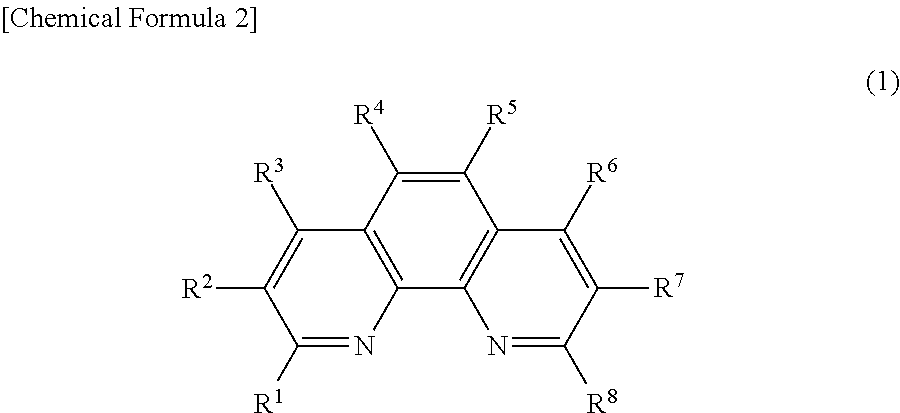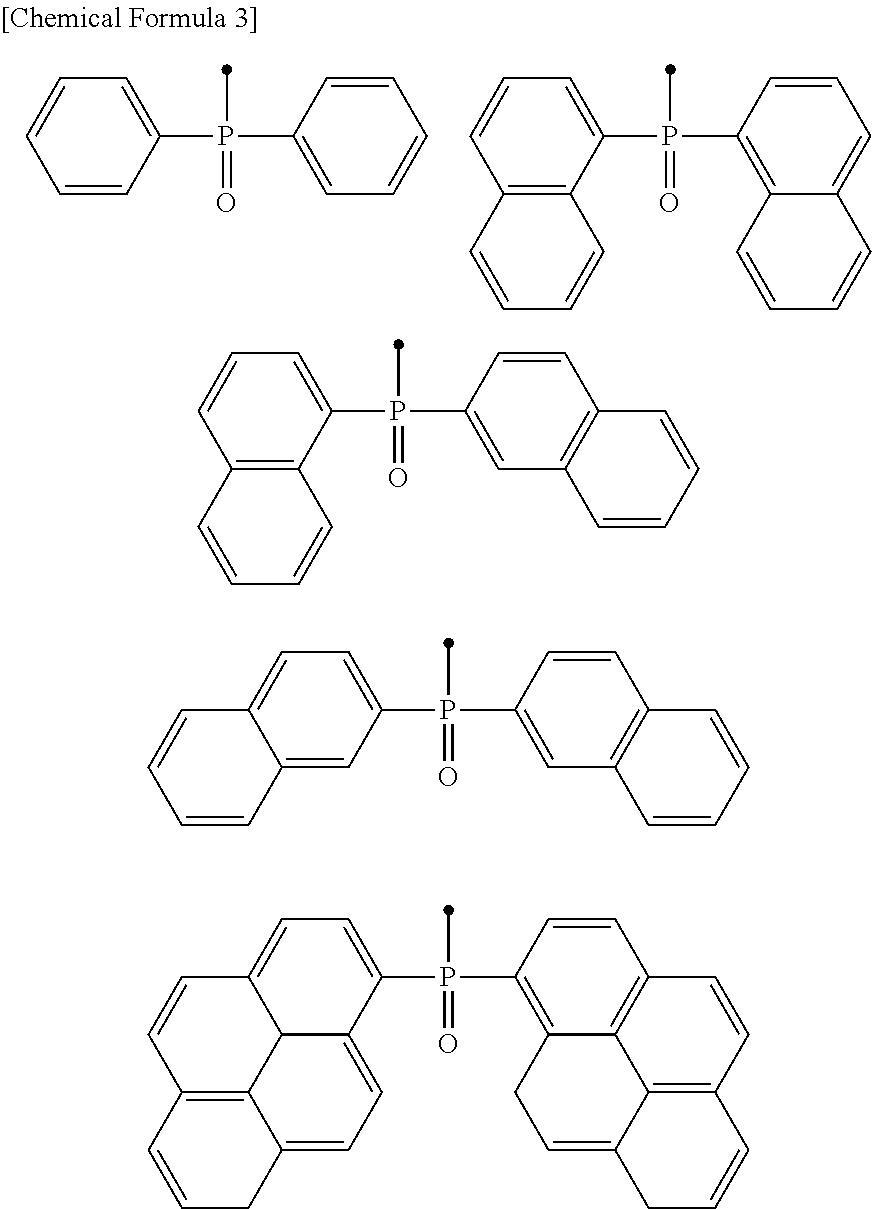Phenanthroline derivative, electronic device containing same, light emitting element, and photoelectric conversion element
- Summary
- Abstract
- Description
- Claims
- Application Information
AI Technical Summary
Benefits of technology
Problems solved by technology
Method used
Image
Examples
synthesis example 1
Synthesis of Compound [A-1]
[0163]12.1 g of 2-acetylpyridine, 17.2 g of 8-aminoquinoline-7-carboaldehyde, 14.0 g of potassium hydroxide and 1000 mL of ethanol were mixed, and the mixture was purged with nitrogen, and then heated and refluxed. After 4.5 hours, the mixture was cooled to room temperature, 500 mL of toluene and 1000 mL of water were then added, and the liquid was separated. The aqueous layer was extracted with 500 mL of toluene twice, and then combined with the foregoing organic layer, and ethanol was distilled off under reduced pressure. The solution was dried with magnesium sulfate, and the solvent was distilled off under reduced pressure, followed by performing vacuum-drying to obtain 23.9 g of an intermediate [a].
[0164]Next, 6.13 g of 1-bromo-4-chlorobenzene and 20.0 mL of dibutyl ether were mixed, and the mixture was cooled to −10° C. To this was added 20.0 mL of n-butyllithium (1.6 M, hexane solution), and the mixture was heated to 0° C., and then stirred for 30 mi...
synthesis example 2
Synthesis of Compound [A-2]
[0167]12.1 g of 3-acetylpyridine, 17.2 g of 8-aminoquinoline-7-carboaldehyde, 14.0 g of potassium hydroxide and 1000 mL of ethanol were mixed, and the mixture was purged with nitrogen, and then heated and refluxed. After 4.5 hours, the mixture was cooled to room temperature, 500 mL of toluene and 1000 mL of water were then added, and the liquid was separated. The aqueous layer was extracted with 500 mL of toluene twice, and then combined with the foregoing organic layer, and ethanol was distilled off under reduced pressure. The solution was dried with anhydrous sodium sulfate, and the solvent was distilled off under reduced pressure, followed by performing vacuum-drying to obtain 14.4 g of an intermediate [c].
[0168]Next, 6.13 g of 1-bromo-3-chlorobenzene and 20.0 mL of dibutyl ether were mixed, and the mixture was cooled to −10° C. To this was added 20.0 mL of n-butyllithium (1.6 M, hexane solution), and the mixture was heated to 0° C., and then stirred fo...
synthesis example 3
Synthesis of Compound [A-3]
[0171]15.5 g of 4′-chloroacetophenone, 17.2 g of 8-aminoquinoline-7-carboaldehyde, 14.0 g of potassium hydroxide and 1000 mL of ethanol were mixed, and the mixture was purged with nitrogen, and then heated and refluxed. After 4.5 hours, the mixture was cooled to room temperature, 500 mL of toluene and 1000 mL of water were then added, and the liquid was separated. The aqueous layer was extracted with 500 mL of toluene twice, and then combined with the foregoing organic layer, and ethanol was distilled off under reduced pressure. The solution was dried with anhydrous sodium sulfate, and the solvent was distilled off under reduced pressure, followed by performing vacuum-drying to obtain 25.9 g of an intermediate [e].
[0172]Next, 13.6 g of the intermediate [e], 17.8 g of bis(pinacolato)diboron, 13.8 g of potassium acetate and 468 mL of 1, 4-dioxane were mixed, the mixture was purged with nitrogen, 538 mg of bis(dibenzylideneacetone)palladium (0) and 892 mg of ...
PUM
 Login to View More
Login to View More Abstract
Description
Claims
Application Information
 Login to View More
Login to View More - R&D
- Intellectual Property
- Life Sciences
- Materials
- Tech Scout
- Unparalleled Data Quality
- Higher Quality Content
- 60% Fewer Hallucinations
Browse by: Latest US Patents, China's latest patents, Technical Efficacy Thesaurus, Application Domain, Technology Topic, Popular Technical Reports.
© 2025 PatSnap. All rights reserved.Legal|Privacy policy|Modern Slavery Act Transparency Statement|Sitemap|About US| Contact US: help@patsnap.com



